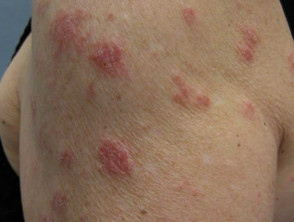What is nummular dermatitis?
Nummular dermatitis is a common inflammatory disorder of the skin. It is also known as nummular eczema, discoid eczema or discoid dermatitis due to its distinctive, disc-shaped lesions. It can also be referred to as exudative neurodermatitis or nummular eczematous dermatitis.
Nummular dermatitis
What is drug-induced nummular dermatitis?
The drug-induced form of nummular dermatitis is diagnosed when its onset is associated with certain medications.
Who gets drug-induced nummular dermatitis?
Drug-induced nummular dermatitis has similar risk factors to the non-drug-induced form of nummular dermatitis; these include:
- Sex — it occurs more frequently in men than in women
- Age — it most often arises in men in their 60s and 70s and in women in their 20s and 30s
- Existing dermatitis, especially a history of dry skin or stasis dermatitis
- A skin injury, such as thermal burns, chemical burns, cuts, abrasions or insect bites and stings
- Cold, dry weather.
What causes drug-induced nummular dermatitis?
Nummular dermatitis can be caused by drugs that affect the function of the epidermal barrier or immune response. Drugs that can lead to excessive skin dryness and dermatitis include:
- Diuretics
- Statins
- Immune-modulating drugs
What are the clinical features of nummular dermatitis?
Nummular dermatitis presents with bilateral, well-defined circular, oval or disc-shaped erythematous plaques. They can be dry or exudative (oozy).
- The plaques are usually several centimetres in diameter.
- They most commonly appear on the individual’s limbs, trunk, or feet.
- The plaques may be erythematous or bluish purple in colour; they can later flatten to hyperpigmented macules.
- Yellowish crusting is associated with Staphylococcus aureus colonisation or infection.
- Pruritus may be intense, to the point where sleep is disturbed.
- Scratching may lead to lichen simplex chronicus, especially on the limbs, scalp or scrotum.
How is drug-induced nummular dermatitis diagnosed?
The diagnosis of drug-induced nummular dermatitis is based on taking a careful patient history and a physical examination. Additional investigations may include:
- Swabs for bacterial culture
- Patch tests, if contact allergy is a possible cause of dermatitis.
How is drug-induced nummular dermatitis treated?
Treatments for nummular dermatitis aim to rehydrate the skin and repair the epidermal barrier. Treatment can include:
- Lukewarm baths or showers using a non-soap cleanser
- Emollients
- Antibiotics to treat bacterial infections
- Topical corticosteroids
- Phototherapy
- Immune-modulating medications, such as methotrexate.
What is the outcome for drug-induced nummular dermatitis?
Nummular dermatitis may take months or sometimes years to resolve. When drug-induced, it may clear up more quickly on the cessation of the medicine that caused dermatitis to appear.
